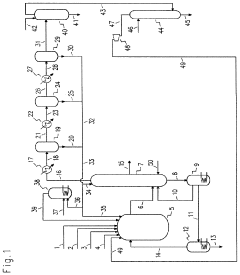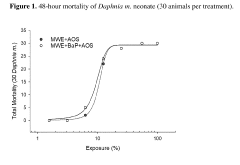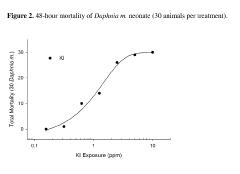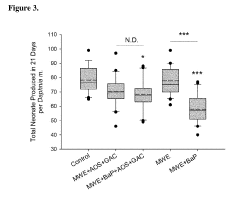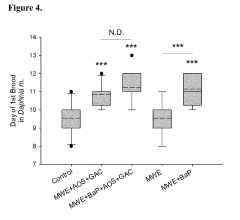Decoding the Science Behind Carbon Tetrachloride's Solvent Properties
JUL 2, 20258 MIN READ
Generate Your Research Report Instantly with AI Agent
Patsnap Eureka helps you evaluate technical feasibility & market potential.
CCl4 Solvent Properties
Carbon tetrachloride (CCl4) has long been recognized as a powerful solvent due to its unique chemical properties. Its effectiveness as a solvent stems from its molecular structure and the resulting intermolecular forces. The tetrahedral arrangement of chlorine atoms around the central carbon atom gives CCl4 a symmetrical, non-polar structure. This non-polarity is key to its solvent properties, as it allows CCl4 to dissolve other non-polar substances effectively.
The absence of a dipole moment in CCl4 means that it primarily interacts with other molecules through weak van der Waals forces. These forces, while individually weak, can collectively provide significant attractive interactions between CCl4 and solute molecules. This characteristic makes CCl4 particularly effective at dissolving organic compounds, such as fats, oils, and many synthetic polymers, which are also predominantly non-polar in nature.
CCl4's high density (1.59 g/cm³ at 20°C) contributes to its solvent properties by facilitating the separation of dissolved substances from water-based mixtures. This property has made it valuable in various extraction processes, where it can efficiently remove organic compounds from aqueous solutions. Additionally, its low boiling point (76.7°C) allows for easy separation of the solvent from dissolved substances through distillation, making it useful in purification processes.
The solvent power of CCl4 is further enhanced by its ability to form weak complexes with some solutes through halogen bonding. The chlorine atoms in CCl4 can act as weak electron acceptors, allowing for subtle interactions with electron-rich regions of solute molecules. This property expands the range of substances that CCl4 can effectively dissolve, including some slightly polar compounds.
However, it's important to note that CCl4's solvent properties are not universal. It is ineffective at dissolving highly polar substances or ionic compounds due to its non-polar nature. Water, for instance, is immiscible with CCl4, leading to the formation of distinct layers when the two liquids are mixed. This limitation actually becomes an advantage in certain applications, such as liquid-liquid extraction techniques used in chemical analysis and purification.
The chemical inertness of CCl4 also contributes to its effectiveness as a solvent. It does not readily react with many organic compounds, allowing it to dissolve them without altering their chemical structure. This stability makes it particularly useful in spectroscopic studies and other analytical applications where maintaining the integrity of the dissolved substance is crucial.
The absence of a dipole moment in CCl4 means that it primarily interacts with other molecules through weak van der Waals forces. These forces, while individually weak, can collectively provide significant attractive interactions between CCl4 and solute molecules. This characteristic makes CCl4 particularly effective at dissolving organic compounds, such as fats, oils, and many synthetic polymers, which are also predominantly non-polar in nature.
CCl4's high density (1.59 g/cm³ at 20°C) contributes to its solvent properties by facilitating the separation of dissolved substances from water-based mixtures. This property has made it valuable in various extraction processes, where it can efficiently remove organic compounds from aqueous solutions. Additionally, its low boiling point (76.7°C) allows for easy separation of the solvent from dissolved substances through distillation, making it useful in purification processes.
The solvent power of CCl4 is further enhanced by its ability to form weak complexes with some solutes through halogen bonding. The chlorine atoms in CCl4 can act as weak electron acceptors, allowing for subtle interactions with electron-rich regions of solute molecules. This property expands the range of substances that CCl4 can effectively dissolve, including some slightly polar compounds.
However, it's important to note that CCl4's solvent properties are not universal. It is ineffective at dissolving highly polar substances or ionic compounds due to its non-polar nature. Water, for instance, is immiscible with CCl4, leading to the formation of distinct layers when the two liquids are mixed. This limitation actually becomes an advantage in certain applications, such as liquid-liquid extraction techniques used in chemical analysis and purification.
The chemical inertness of CCl4 also contributes to its effectiveness as a solvent. It does not readily react with many organic compounds, allowing it to dissolve them without altering their chemical structure. This stability makes it particularly useful in spectroscopic studies and other analytical applications where maintaining the integrity of the dissolved substance is crucial.
Market Demand Analysis
Carbon tetrachloride's solvent properties have long been recognized in various industries, driving a significant market demand for this versatile compound. The global market for carbon tetrachloride has experienced fluctuations due to environmental regulations, but it continues to maintain a steady presence in specific sectors.
The primary market for carbon tetrachloride lies in its use as a feedstock for the production of chlorofluorocarbons (CFCs) and their alternatives. While the Montreal Protocol has phased out CFCs, the demand for carbon tetrachloride in the production of hydrochlorofluorocarbons (HCFCs) and hydrofluorocarbons (HFCs) remains substantial. These compounds are widely used in refrigeration, air conditioning, and foam blowing applications.
In the pharmaceutical industry, carbon tetrachloride's solvent properties make it valuable in the synthesis of various drugs and intermediates. Its ability to dissolve a wide range of organic compounds without reacting with them has led to its continued use in certain controlled laboratory environments. However, stringent safety measures are required due to its toxicity.
The agrochemical sector also contributes to the demand for carbon tetrachloride. It serves as a precursor in the production of certain pesticides and herbicides, although alternatives are increasingly being sought due to environmental concerns.
Despite its declining use as a direct solvent in consumer products, carbon tetrachloride still finds niche applications in specialized industrial cleaning processes. Its effectiveness in removing greases, oils, and other organic contaminants from metal surfaces maintains a small but persistent demand in the manufacturing sector.
The fire suppression industry has historically been a significant consumer of carbon tetrachloride due to its fire extinguishing properties. However, this application has been largely phased out in many countries due to its ozone-depleting potential and toxicity concerns. Nevertheless, some legacy systems still utilize carbon tetrachloride, contributing to a residual market demand.
Market analysis indicates a gradual shift towards more environmentally friendly alternatives across various applications. This trend is driven by increasing regulatory pressure and growing environmental awareness. As a result, the market for carbon tetrachloride is expected to contract in traditional sectors while potentially expanding in niche areas where its unique solvent properties remain irreplaceable.
The geographical distribution of carbon tetrachloride demand is influenced by regional regulations and industrial development. Emerging economies in Asia-Pacific, particularly China and India, represent growing markets due to their expanding chemical and pharmaceutical industries. In contrast, North America and Europe have seen a decline in demand, primarily due to stricter environmental regulations.
The primary market for carbon tetrachloride lies in its use as a feedstock for the production of chlorofluorocarbons (CFCs) and their alternatives. While the Montreal Protocol has phased out CFCs, the demand for carbon tetrachloride in the production of hydrochlorofluorocarbons (HCFCs) and hydrofluorocarbons (HFCs) remains substantial. These compounds are widely used in refrigeration, air conditioning, and foam blowing applications.
In the pharmaceutical industry, carbon tetrachloride's solvent properties make it valuable in the synthesis of various drugs and intermediates. Its ability to dissolve a wide range of organic compounds without reacting with them has led to its continued use in certain controlled laboratory environments. However, stringent safety measures are required due to its toxicity.
The agrochemical sector also contributes to the demand for carbon tetrachloride. It serves as a precursor in the production of certain pesticides and herbicides, although alternatives are increasingly being sought due to environmental concerns.
Despite its declining use as a direct solvent in consumer products, carbon tetrachloride still finds niche applications in specialized industrial cleaning processes. Its effectiveness in removing greases, oils, and other organic contaminants from metal surfaces maintains a small but persistent demand in the manufacturing sector.
The fire suppression industry has historically been a significant consumer of carbon tetrachloride due to its fire extinguishing properties. However, this application has been largely phased out in many countries due to its ozone-depleting potential and toxicity concerns. Nevertheless, some legacy systems still utilize carbon tetrachloride, contributing to a residual market demand.
Market analysis indicates a gradual shift towards more environmentally friendly alternatives across various applications. This trend is driven by increasing regulatory pressure and growing environmental awareness. As a result, the market for carbon tetrachloride is expected to contract in traditional sectors while potentially expanding in niche areas where its unique solvent properties remain irreplaceable.
The geographical distribution of carbon tetrachloride demand is influenced by regional regulations and industrial development. Emerging economies in Asia-Pacific, particularly China and India, represent growing markets due to their expanding chemical and pharmaceutical industries. In contrast, North America and Europe have seen a decline in demand, primarily due to stricter environmental regulations.
Technical Challenges
Carbon tetrachloride's solvent properties have been widely utilized in various industries, but its use faces significant technical challenges due to environmental and health concerns. The primary obstacle lies in finding suitable alternatives that can match its effectiveness while mitigating its harmful effects.
One of the main technical challenges is developing environmentally friendly substitutes that possess similar solvent properties. Carbon tetrachloride's unique ability to dissolve a wide range of non-polar compounds makes it difficult to replace with a single alternative. Researchers are exploring various combinations of solvents and novel compounds to replicate its versatility without the associated risks.
Another challenge is the modification of existing industrial processes that rely on carbon tetrachloride. Many manufacturing systems and equipment are designed specifically for its use, making the transition to alternative solvents complex and costly. Engineers must develop new protocols and adapt machinery to accommodate different solvents, which often have distinct physical and chemical properties.
The disposal and remediation of carbon tetrachloride contamination present additional technical hurdles. Its persistence in the environment and tendency to accumulate in groundwater make it challenging to remove once released. Developing effective cleanup technologies that can efficiently extract and neutralize carbon tetrachloride from soil and water systems remains an ongoing area of research.
Safety concerns in handling and storage also pose technical challenges. While carbon tetrachloride's non-flammability is advantageous, many potential substitutes may have different safety profiles. This necessitates the development of new safety protocols, storage solutions, and handling equipment to manage these alternative solvents effectively.
Furthermore, the analytical and quality control aspects of processes that traditionally use carbon tetrachloride require recalibration. Many standardized testing methods and analytical procedures are optimized for carbon tetrachloride-based systems. Adapting these methods to work with new solvents while maintaining accuracy and reliability is a significant technical challenge for laboratories and quality control departments.
Lastly, the regulatory landscape surrounding carbon tetrachloride and its alternatives presents a complex challenge. As environmental regulations become more stringent, industries must navigate a shifting legal framework while seeking viable substitutes. This requires ongoing research and development efforts to stay ahead of regulatory changes and ensure compliance with evolving environmental standards.
One of the main technical challenges is developing environmentally friendly substitutes that possess similar solvent properties. Carbon tetrachloride's unique ability to dissolve a wide range of non-polar compounds makes it difficult to replace with a single alternative. Researchers are exploring various combinations of solvents and novel compounds to replicate its versatility without the associated risks.
Another challenge is the modification of existing industrial processes that rely on carbon tetrachloride. Many manufacturing systems and equipment are designed specifically for its use, making the transition to alternative solvents complex and costly. Engineers must develop new protocols and adapt machinery to accommodate different solvents, which often have distinct physical and chemical properties.
The disposal and remediation of carbon tetrachloride contamination present additional technical hurdles. Its persistence in the environment and tendency to accumulate in groundwater make it challenging to remove once released. Developing effective cleanup technologies that can efficiently extract and neutralize carbon tetrachloride from soil and water systems remains an ongoing area of research.
Safety concerns in handling and storage also pose technical challenges. While carbon tetrachloride's non-flammability is advantageous, many potential substitutes may have different safety profiles. This necessitates the development of new safety protocols, storage solutions, and handling equipment to manage these alternative solvents effectively.
Furthermore, the analytical and quality control aspects of processes that traditionally use carbon tetrachloride require recalibration. Many standardized testing methods and analytical procedures are optimized for carbon tetrachloride-based systems. Adapting these methods to work with new solvents while maintaining accuracy and reliability is a significant technical challenge for laboratories and quality control departments.
Lastly, the regulatory landscape surrounding carbon tetrachloride and its alternatives presents a complex challenge. As environmental regulations become more stringent, industries must navigate a shifting legal framework while seeking viable substitutes. This requires ongoing research and development efforts to stay ahead of regulatory changes and ensure compliance with evolving environmental standards.
Current Solutions
01 Solvent properties and applications
Carbon tetrachloride is a versatile solvent with excellent dissolving capabilities for various organic compounds. It is widely used in industrial processes, chemical synthesis, and as a cleaning agent due to its non-flammability and high solvency power.- Solvent properties and applications: Carbon tetrachloride is a versatile solvent with excellent dissolving capabilities for various organic compounds. It is widely used in industrial processes, chemical synthesis, and as a cleaning agent due to its non-flammability and high solvency power.
- Environmental and safety considerations: Due to its toxicity and ozone-depleting properties, the use of carbon tetrachloride as a solvent has been restricted in many applications. Alternative solvents and processes have been developed to replace it in various industries, addressing environmental and health concerns.
- Purification and separation techniques: Carbon tetrachloride is used in various purification and separation processes, including liquid-liquid extraction, azeotropic distillation, and as a solvent for recrystallization. Its unique properties make it effective in isolating and purifying certain compounds.
- Reactions and chemical transformations: As a solvent, carbon tetrachloride facilitates various chemical reactions and transformations. It is particularly useful in halogenation reactions, free radical processes, and as a medium for spectroscopic studies due to its transparency in certain wavelength ranges.
- Physical properties and characterization: Carbon tetrachloride exhibits specific physical properties that contribute to its solvent characteristics, such as its boiling point, density, and polarity. These properties are important in determining its suitability for various applications and in developing analytical methods for its detection and quantification.
02 Extraction and separation processes
Carbon tetrachloride is utilized in extraction and separation processes, particularly for isolating organic compounds from mixtures. Its unique solvent properties make it effective in liquid-liquid extraction, purification, and analytical chemistry applications.Expand Specific Solutions03 Reaction medium and synthesis
As a reaction medium, carbon tetrachloride facilitates various chemical reactions and syntheses. Its inert nature and ability to dissolve a wide range of organic compounds make it suitable for use in organic synthesis, polymerization reactions, and as a solvent for spectroscopic studies.Expand Specific Solutions04 Environmental and safety considerations
Due to its toxicity and environmental impact, the use of carbon tetrachloride as a solvent has been restricted in many applications. Alternative solvents and processes have been developed to replace carbon tetrachloride while maintaining similar solvent properties and effectiveness.Expand Specific Solutions05 Physical and chemical characteristics
Carbon tetrachloride exhibits unique physical and chemical properties that contribute to its solvent capabilities. These include its high density, low boiling point, and non-polar nature, which influence its behavior as a solvent and its interactions with various substances.Expand Specific Solutions
Key Industry Players
The competitive landscape for carbon tetrachloride's solvent properties is characterized by a mature market with established players. The industry is in a stable phase, with moderate growth expected due to ongoing industrial applications. Market size is significant, driven by demand in chemical manufacturing and cleaning processes. Technologically, the field is well-developed, with companies like Evonik Operations GmbH, Indian Oil Corp. Ltd., and PetroChina Co., Ltd. leading in production and application. Academic institutions such as Central South University and Zhengzhou University contribute to research advancements. The focus is shifting towards safer alternatives and environmental considerations, influencing future market dynamics.
Evonik Operations GmbH
Technical Solution: Evonik has developed advanced solvent systems incorporating carbon tetrachloride for specialized applications. Their approach involves optimizing the molecular interactions between carbon tetrachloride and target substances to enhance dissolution efficiency. The company has implemented a proprietary process that utilizes carbon tetrachloride's strong van der Waals forces and its ability to form temporary dipoles, allowing for effective solvation of non-polar compounds[1]. Evonik's research has also focused on mitigating the environmental impact of carbon tetrachloride use through closed-loop systems and advanced recycling techniques[2].
Strengths: High efficiency in dissolving non-polar substances, specialized expertise in solvent systems. Weaknesses: Environmental concerns associated with carbon tetrachloride use, potential regulatory challenges.
Blue Cube IP LLC
Technical Solution: Blue Cube IP LLC has pioneered innovative applications of carbon tetrachloride as a solvent in industrial processes. Their technology leverages the compound's unique tetrahedral molecular structure and strong carbon-chlorine bonds to achieve superior solvation properties for specific chemical reactions[3]. The company has developed a patented process that enhances the selectivity of carbon tetrachloride in multi-component systems, allowing for more precise separation and purification of target compounds[4]. Blue Cube's approach also includes the integration of advanced safety measures to address the potential health and environmental risks associated with carbon tetrachloride use.
Strengths: Highly selective solvation process, improved safety protocols. Weaknesses: Limited applicability outside specific industrial processes, ongoing environmental concerns.
Core Innovations
Chlorinolysis process for producing carbon tetrachloride
PatentActiveUS20210130266A1
Innovation
- A process involving a chlorination zone with chlorine, a C1 chlorinated compound, and a carbon/second chlorine source to produce a reaction mixture that favors the formation of carbon tetrachloride over perchloroethylene, using waste products as the carbon/second chlorine source to enhance efficiency and reduce impurity formation.
Treatment of water effluent
PatentPendingUS20190092658A1
Innovation
- A method and system using a filter material comprising a porous carbon support layer and silicate wool or glass wool with distributed halogens or halides, where an electric current is passed through the filter material to adsorb and decompose hormonal contaminants from aqueous effluent streams.
Environmental Impact
Carbon tetrachloride, once widely used as a solvent, has been recognized as a significant environmental hazard due to its persistent and toxic nature. The environmental impact of this compound is far-reaching and multifaceted, affecting various ecosystems and posing risks to human health.
In the atmosphere, carbon tetrachloride acts as a potent ozone-depleting substance. It has a long atmospheric lifetime of approximately 26 years, allowing it to reach the stratosphere where it catalyzes the destruction of ozone molecules. This depletion of the ozone layer increases the amount of harmful ultraviolet radiation reaching the Earth's surface, potentially causing ecological disruptions and health issues for humans and wildlife.
When released into soil and water systems, carbon tetrachloride can persist for extended periods due to its resistance to biodegradation. It has the potential to contaminate groundwater sources, posing long-term risks to drinking water supplies. The compound's high mobility in soil further exacerbates its spread through environmental matrices, potentially affecting large areas beyond the initial point of release.
Aquatic ecosystems are particularly vulnerable to carbon tetrachloride contamination. The compound can accumulate in the tissues of aquatic organisms, leading to bioaccumulation up the food chain. This process can result in higher concentrations in top predators, potentially causing reproductive issues, developmental abnormalities, and other toxic effects in marine life.
The impact on terrestrial ecosystems is equally concerning. Soil contamination by carbon tetrachloride can inhibit plant growth and alter soil microbial communities, disrupting nutrient cycles and ecosystem functions. Wildlife exposed to contaminated soil or water may suffer from various health effects, including liver and kidney damage, which can have cascading effects on ecosystem balance.
Human exposure to carbon tetrachloride, whether through contaminated air, water, or soil, poses significant health risks. The compound is classified as a probable human carcinogen and is known to cause liver and kidney damage. Occupational exposure in industries that historically used carbon tetrachloride as a solvent has been linked to increased cancer rates and other chronic health issues.
The global recognition of carbon tetrachloride's environmental impact has led to its phase-out under the Montreal Protocol, significantly reducing its production and use. However, the compound's persistence means that its environmental effects continue to be a concern, necessitating ongoing monitoring and remediation efforts in affected areas.
In the atmosphere, carbon tetrachloride acts as a potent ozone-depleting substance. It has a long atmospheric lifetime of approximately 26 years, allowing it to reach the stratosphere where it catalyzes the destruction of ozone molecules. This depletion of the ozone layer increases the amount of harmful ultraviolet radiation reaching the Earth's surface, potentially causing ecological disruptions and health issues for humans and wildlife.
When released into soil and water systems, carbon tetrachloride can persist for extended periods due to its resistance to biodegradation. It has the potential to contaminate groundwater sources, posing long-term risks to drinking water supplies. The compound's high mobility in soil further exacerbates its spread through environmental matrices, potentially affecting large areas beyond the initial point of release.
Aquatic ecosystems are particularly vulnerable to carbon tetrachloride contamination. The compound can accumulate in the tissues of aquatic organisms, leading to bioaccumulation up the food chain. This process can result in higher concentrations in top predators, potentially causing reproductive issues, developmental abnormalities, and other toxic effects in marine life.
The impact on terrestrial ecosystems is equally concerning. Soil contamination by carbon tetrachloride can inhibit plant growth and alter soil microbial communities, disrupting nutrient cycles and ecosystem functions. Wildlife exposed to contaminated soil or water may suffer from various health effects, including liver and kidney damage, which can have cascading effects on ecosystem balance.
Human exposure to carbon tetrachloride, whether through contaminated air, water, or soil, poses significant health risks. The compound is classified as a probable human carcinogen and is known to cause liver and kidney damage. Occupational exposure in industries that historically used carbon tetrachloride as a solvent has been linked to increased cancer rates and other chronic health issues.
The global recognition of carbon tetrachloride's environmental impact has led to its phase-out under the Montreal Protocol, significantly reducing its production and use. However, the compound's persistence means that its environmental effects continue to be a concern, necessitating ongoing monitoring and remediation efforts in affected areas.
Regulatory Framework
The regulatory framework surrounding carbon tetrachloride has evolved significantly over the past few decades due to its potential environmental and health impacts. At the international level, the Montreal Protocol, signed in 1987, marked a crucial turning point in the regulation of ozone-depleting substances, including carbon tetrachloride. This agreement phased out the production and consumption of carbon tetrachloride in developed countries by 1996 and in developing countries by 2010.
In the United States, the Environmental Protection Agency (EPA) has implemented stringent regulations on carbon tetrachloride under various legislative acts. The Toxic Substances Control Act (TSCA) restricts the manufacture, processing, and distribution of carbon tetrachloride. The Clean Air Act classifies it as a hazardous air pollutant, requiring strict emission controls. Additionally, the Safe Drinking Water Act establishes a maximum contaminant level for carbon tetrachloride in public water systems.
The European Union has also taken decisive action through the REACH (Registration, Evaluation, Authorization, and Restriction of Chemicals) regulation. Under REACH, carbon tetrachloride is subject to authorization, meaning its use is severely restricted and requires specific approval. The EU has further banned its use in consumer products and limited its application in industrial processes.
Occupational safety regulations worldwide have set strict exposure limits for workers handling carbon tetrachloride. For instance, the Occupational Safety and Health Administration (OSHA) in the U.S. has established permissible exposure limits and requires employers to implement engineering controls and personal protective equipment to minimize worker exposure.
Despite these regulations, carbon tetrachloride continues to be used in certain controlled applications, such as in the production of hydrofluorocarbons and as a feedstock for other chemicals. These uses are subject to stringent reporting and monitoring requirements to ensure compliance with environmental and safety standards.
The global regulatory landscape for carbon tetrachloride reflects a balance between recognizing its valuable solvent properties and mitigating its potential risks. As scientific understanding of its environmental and health impacts continues to evolve, regulatory frameworks are likely to adapt, potentially leading to further restrictions or alternative approaches to manage its use and production.
In the United States, the Environmental Protection Agency (EPA) has implemented stringent regulations on carbon tetrachloride under various legislative acts. The Toxic Substances Control Act (TSCA) restricts the manufacture, processing, and distribution of carbon tetrachloride. The Clean Air Act classifies it as a hazardous air pollutant, requiring strict emission controls. Additionally, the Safe Drinking Water Act establishes a maximum contaminant level for carbon tetrachloride in public water systems.
The European Union has also taken decisive action through the REACH (Registration, Evaluation, Authorization, and Restriction of Chemicals) regulation. Under REACH, carbon tetrachloride is subject to authorization, meaning its use is severely restricted and requires specific approval. The EU has further banned its use in consumer products and limited its application in industrial processes.
Occupational safety regulations worldwide have set strict exposure limits for workers handling carbon tetrachloride. For instance, the Occupational Safety and Health Administration (OSHA) in the U.S. has established permissible exposure limits and requires employers to implement engineering controls and personal protective equipment to minimize worker exposure.
Despite these regulations, carbon tetrachloride continues to be used in certain controlled applications, such as in the production of hydrofluorocarbons and as a feedstock for other chemicals. These uses are subject to stringent reporting and monitoring requirements to ensure compliance with environmental and safety standards.
The global regulatory landscape for carbon tetrachloride reflects a balance between recognizing its valuable solvent properties and mitigating its potential risks. As scientific understanding of its environmental and health impacts continues to evolve, regulatory frameworks are likely to adapt, potentially leading to further restrictions or alternative approaches to manage its use and production.
Unlock deeper insights with Patsnap Eureka Quick Research — get a full tech report to explore trends and direct your research. Try now!
Generate Your Research Report Instantly with AI Agent
Supercharge your innovation with Patsnap Eureka AI Agent Platform!
